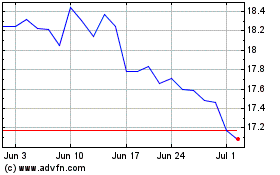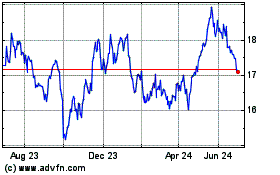By Alejandro Lazo
SAN FRANCISCO -- California Gov. Gavin Newsom recently ended
weeks of traversing burned down, blacked out and evacuated parts of
this state with a dramatic promise: If PG&E Corp couldn't fix
its own problems, he would consider a government takeover.
Widespread blackouts intended to prevent more deadly wildfires
have disrupted the lives of more than two million Californians and
become the biggest crisis of Mr. Newsom's 10 months in office.
Putting his administration in the precarious center of a problem
fueled largely by forces beyond his control could wed his fate
deeper to the crisis.
But political consultants and policy experts say Mr. Newsom may
have no better options than to try to take ownership of the
problem.
"Because the governor is the executive, he gets credit for
things he doesn't really do, and gets blamed for things that are
not really his fault," said Garry South, a political adviser to
former Gov. Gray Davis, who was recalled in 2003, partly due to an
energy crisis. "Gavin Newsom knows this extremely well."
Until now, Mr. Newsom, 52 years old, has had a smooth first
year, helped by a booming economy that allowed for spending
increases on a number of programs. The former San Francisco mayor
and lieutenant governor also has made his mark by repeatedly
engaging President Trump in public spats that play well in the
left-leaning state.
As of September, 44% of Californians approved of Mr. Newsom's
performance as governor, while 32% disapproved, according to the
Public Policy Institute of California. No new public polls have
been conducted since the blackouts began.
In the weeks following the first wave of power shut-offs that
began Oct. 9, Mr. Newsom blamed PG&E's "greed" and
"mismanagement" multiple times in written statements and
appearances, demanding repeatedly that affected customers receive
rebates for the blackouts. The company agreed to pay the
rebates.
No utility has deployed the strategy of shutting down power to
avoid wildfire risk as broadly as PG&E, which is scrambling to
revamp its equipment and trim trees across its 70,000-square-mile
service territory. That equipment -- determined to have sparked 19
wildfires in 2017 and 2018 that collectively killed more than 100
people -- is particularly dangerous when dry, windy conditions
prevail. The company sought chapter 11 bankruptcy protection in
January, citing more than $30 billion in potential liability
costs.
On Tuesday, Mr. Newsom convened a meeting in Sacramento with
PG&E and insurance industry executives, wildfire victims and
debt and equity investors aimed at expediting the company's exit
from bankruptcy, improving its safety standards and limiting the
need for more preventive power outages.
While the state is a party to the bankruptcy proceedings and
California law requires its utilities regulator to sign off on any
final plan, a state takeover of PG&E would be difficult,
experts said, as any offer would have to compete with those being
considered in court. A push to buy the investor-owned utility and
turn it into a giant customer-owned cooperative has gained momentum
in recent weeks, with support from the mayors of San Jose, Oakland
and Sacramento.
At the meeting, Mr. Newsom reiterated his threat that the state
would intervene "if the stakeholders don't come to a swift
resolution that allows for needed safety transformation ahead of
next fire season," a spokesman said. The spokesman didn't offer
further specifics, though the governor has said publicly that a
state plan would keep the utility quasi-independent and he wouldn't
put the general fund, which pays for most public services, at
risk.
S. David Freeman, the former head of the Los Angeles Department
of Water and Power and the Tennessee Valley Authority, said having
one owner take over for another isn't likely to resolve issues that
have built up over decades, particularly given the nature of
PG&E's aging infrastructure.
"This problem is unsolvable under the current situation," Mr.
Freeman said. "In the meantime, we are going to have to put up with
a lot of anguish."
PG&E's chief executive has said it could take a decade for
the company to improve its electric system enough that pre-emptive
blackouts would be largely unnecessary. Mr. Newsom has argued that
while transforming the entire grid might take that long, his aim is
to have a safe utility by the next fire season by identifying the
most dangerous parts of the grid and making targeted
investments.
"I assure you we are not allowing any of this to be the new
normal, and this will not take 10 years to fix," Mr. Newsom said
recently after handing out apples at a food bank for Kincade Fire
evacuees in Santa Rosa.
His comments were met with resounding applause from the crowd.
Debbie Meier, who was living in her car last month after being
evacuated from her home in Windsor, Calif., said she was enthused
by a call from the governor for billionaire investor Warren Buffett
to buy the utility.
"PG&E has run us into the ground over the last 10 years,
somebody else has to do it," she said. "We can't just keep having
this every year."
Mr. South, the former adviser to Mr. Davis, said Mr. Newsom has
an advantage over his onetime boss.
"There is a readily identifiable villain in PG&E," he said.
"He is doing a really good job at pointing that out."
Katie Bays, an energy analyst with corporate consulting firm
Sandhill Strategy, said the governor has so far walked a fine line
using harsh language that resonates with angry voters while still
assuring investors that he will do his best to ensure PG&E has
a solvent future.
Politically, she added, Mr. Newsom's life is likely to become
harder if the state takes control of the company.
"Isn't it easier and better and potentially more expedient to
have PG&E as a punching bag when fires break out?" she
asked.
Write to Alejandro Lazo at alejandro.lazo@wsj.com
(END) Dow Jones Newswires
November 10, 2019 10:14 ET (15:14 GMT)
Copyright (c) 2019 Dow Jones & Company, Inc.
PG&E (NYSE:PCG)
Historical Stock Chart
From Mar 2024 to Apr 2024

PG&E (NYSE:PCG)
Historical Stock Chart
From Apr 2023 to Apr 2024
